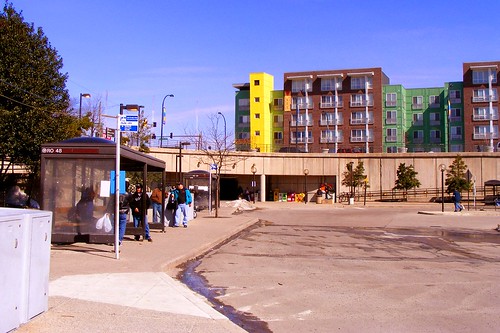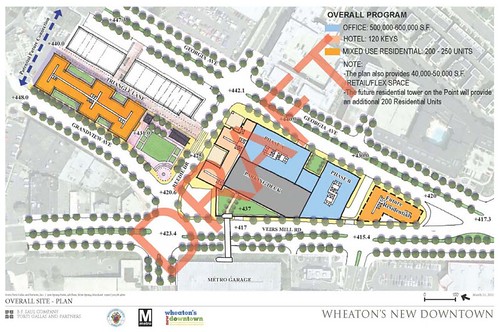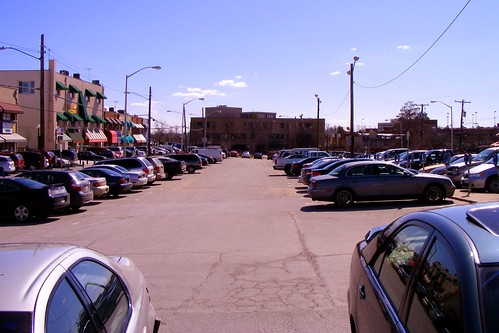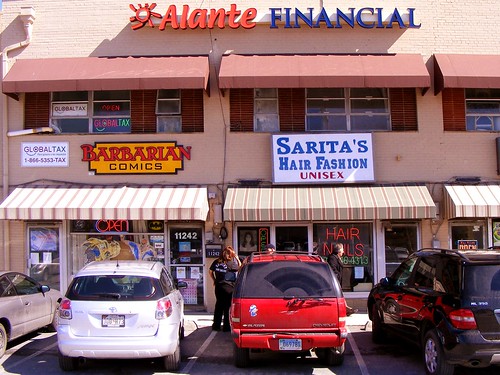Next Tuesday, the Montgomery County Council will choose a development proposal that it hopes will jump-start revitalization in downtown Wheaton.
Two competing proposals have emerged from County Executive Ike Leggett and the council for several publicly-owned properties in the area, both of which include significant office space. Leggett's proposal is larger and enjoys community support, but it may not make economic sense. The council's proposal is smaller, but takes a more deliberate approach to redevelopment.
While residents are impatient to see change in Wheaton, rushing into a redevelopment scheme that could harm existing businesses without quickly creating new value in is not in the community's best interest.

In 2010, Leggett made an agreement with developer B.F. Saul to redevelop several county-owned parcels in the center of downtown Wheaton. On Parking Lot 13, located at the corner of Reedie Drive and Grandview Avenue, B.F. Saul would build a six-story, 250-unit apartment building with ground-floor retail and a new town square in a setup comparable to Bethesda Row.
The developer would also build a platform over the Wheaton Metro station's bus turnaround as the base for a hotel and three 14-story office buildings. With approximately 900,000 square feet, nine times the existing amount of Class A office space in downtown Wheaton, these buildings would bring about 3,600 workers to Wheaton's downtown every day.
Those offices would house the county's Department of Environmental Protection (DEP) and the Department of Permitting Services (DPS), both currently located in Rockville, along with the Park and Planning Commission, currently in Silver Spring.
The county would also like to find a federal government tenant, though the rent cap on government offices will require them to subsidize rent, as they already do for the National Oceanic and Atmospheric Administration's headquarters in downtown Silver Spring.
Leggett wants to set aside $42 million for the project, which would only cover the cost of building the platform. It's unclear how much it would cost to build the rest or whether the county or B.F. Saul would pay for it. Nonetheless, the proposal has been endorsed by the Wheaton Urban District Advisory Committee and Mid-County Citizens Advisory Board, another developer working in Wheaton, and the Gazette.

Concerned about the size and cost of Leggett's proposal, the County Council's Planning, Housing and Economic Development Committee offered a counterproposal last month. In their proposal, estimated to cost $55 million,B.F. Saul the county would build a new town square on Lot 13 with an underground parking garage, at a cost of $2.5 million and $5.6 million, respectively, along with a building for DEP and DPS for $46 million.
There's also room for the Park and Planning Commission if another $46 million is found to build another building. Both buildings would contain 415,000 square feet of office space and hold about 1,600 workers.
"It is misleading to say that $42 million will revitalize Wheaton," says Councilmember George Leventhal, who sits on the committee. (Full disclosure: I used to work for Leventhal.) "The only thing that $42 million buys now is a concrete hat over the bus bay, and if you want to relocate county agencies, the cost will go above $100 million."
Though local blogger Wheaton Calling accuses the council of "throwing a wrench" into the redevelopment process with their counterproposal, the benefits of Leggett's proposal remain unclear. The county's Department of Economic Development usually does a cost-benefit analysis of major public investments, like the $4 million big-box retailer Costco received to open a store in Wheaton Plaza, but they haven't done one for this project.
"The 'end' is not to build a platform, to execute a General Development Agreement, or to attract a federal tenant," writes Jacob Sesker, economic analyst for the County Council, in a report for the PHED committee. "Rather, the desired end is to introduce land uses (to wit, office space) . . . that downtown Wheaton currently lacks and which the market will not provide."

In a phone call with JUTP, Sesker points out that in large-scale redevelopment projects, the best way to start is with the least challenging or expensive parts, like Lot 13. Those improvements will add value to the rest of the development, which makes the expensive parts more profitable to build later on, meaning B.F. Saul will require fewer subsidies.
The platform also has no direct benefit to the community by itself. "Unlike a school or a train, a platform does not teach any child to read and does not take anyone to work." Without those benefits, Sesker says, "if it is not generating revenue, then it probably is not a good investment."
"The County Council is the steward of public money," adds Leventhal. "If we're going to spend that money, it's reasonable to ask what this will do for taxpayers. We have to be very cautious about our decision, and we need much better analysis than what we've gotten."
Some still say offices just don't make sense in Wheaton. In 2009, a group of real estate and design experts commissioned by the Urban Land Institute to offer recommendations for redevelopment concluded that there is "no inherent reason" for offices to locate there:
Instead, the panel suggests building apartments and townhomes to draw young professionals who are being priced out of Silver Spring, a handful of chain stores and restaurants outside of Wheaton Plaza to "anchor" the downtown, and a small music venue taking advantage of its proximity to the renowned Chuck Levin's Washington Music Center.
On Lot 13, they proposed a town square and a smaller "2-3 story building" with shops and apartments. Like Sesker, they recommend waiting to build over the bus turnaround, as that site is the "most valuable" in downtown Wheaton and has "the potential for the greatest density." This vision, particularly the focus on music and entertainment, fits in with earlier proposals for Wheaton that were well-received by the community.

No matter what the county does, they should heed the ULI panel's warning on any development in Wheaton: "Wheaton's strengths, such as its eclectic retail mix, are also quite fragile, and could be irreparably harmed by any redevelopment projects that are ill-conceived or rushed. Thus, the panel recommends a gradual approach to redevelopment," they write. "An attempt to force a desired result . . . would not only fail, but would also end up undermining the unique identity that Wheaton already possesses."
We've been waiting for a new Wheaton for twenty years, so it's understandable some are impatient. But rushing into any project without a thorough understanding of its potential costs and benefits could destroy what people already like about the old Wheaton while limiting its future potential.
Two competing proposals have emerged from County Executive Ike Leggett and the council for several publicly-owned properties in the area, both of which include significant office space. Leggett's proposal is larger and enjoys community support, but it may not make economic sense. The council's proposal is smaller, but takes a more deliberate approach to redevelopment.
While residents are impatient to see change in Wheaton, rushing into a redevelopment scheme that could harm existing businesses without quickly creating new value in is not in the community's best interest.

In 2010, Leggett made an agreement with developer B.F. Saul to redevelop several county-owned parcels in the center of downtown Wheaton. On Parking Lot 13, located at the corner of Reedie Drive and Grandview Avenue, B.F. Saul would build a six-story, 250-unit apartment building with ground-floor retail and a new town square in a setup comparable to Bethesda Row.
The developer would also build a platform over the Wheaton Metro station's bus turnaround as the base for a hotel and three 14-story office buildings. With approximately 900,000 square feet, nine times the existing amount of Class A office space in downtown Wheaton, these buildings would bring about 3,600 workers to Wheaton's downtown every day.
Those offices would house the county's Department of Environmental Protection (DEP) and the Department of Permitting Services (DPS), both currently located in Rockville, along with the Park and Planning Commission, currently in Silver Spring.
The county would also like to find a federal government tenant, though the rent cap on government offices will require them to subsidize rent, as they already do for the National Oceanic and Atmospheric Administration's headquarters in downtown Silver Spring.
Leggett wants to set aside $42 million for the project, which would only cover the cost of building the platform. It's unclear how much it would cost to build the rest or whether the county or B.F. Saul would pay for it. Nonetheless, the proposal has been endorsed by the Wheaton Urban District Advisory Committee and Mid-County Citizens Advisory Board, another developer working in Wheaton, and the Gazette.

Concerned about the size and cost of Leggett's proposal, the County Council's Planning, Housing and Economic Development Committee offered a counterproposal last month. In their proposal, estimated to cost $55 million,
There's also room for the Park and Planning Commission if another $46 million is found to build another building. Both buildings would contain 415,000 square feet of office space and hold about 1,600 workers.
"It is misleading to say that $42 million will revitalize Wheaton," says Councilmember George Leventhal, who sits on the committee. (Full disclosure: I used to work for Leventhal.) "The only thing that $42 million buys now is a concrete hat over the bus bay, and if you want to relocate county agencies, the cost will go above $100 million."
Though local blogger Wheaton Calling accuses the council of "throwing a wrench" into the redevelopment process with their counterproposal, the benefits of Leggett's proposal remain unclear. The county's Department of Economic Development usually does a cost-benefit analysis of major public investments, like the $4 million big-box retailer Costco received to open a store in Wheaton Plaza, but they haven't done one for this project.
"The 'end' is not to build a platform, to execute a General Development Agreement, or to attract a federal tenant," writes Jacob Sesker, economic analyst for the County Council, in a report for the PHED committee. "Rather, the desired end is to introduce land uses (to wit, office space) . . . that downtown Wheaton currently lacks and which the market will not provide."

In a phone call with JUTP, Sesker points out that in large-scale redevelopment projects, the best way to start is with the least challenging or expensive parts, like Lot 13. Those improvements will add value to the rest of the development, which makes the expensive parts more profitable to build later on, meaning B.F. Saul will require fewer subsidies.
The platform also has no direct benefit to the community by itself. "Unlike a school or a train, a platform does not teach any child to read and does not take anyone to work." Without those benefits, Sesker says, "if it is not generating revenue, then it probably is not a good investment."
"The County Council is the steward of public money," adds Leventhal. "If we're going to spend that money, it's reasonable to ask what this will do for taxpayers. We have to be very cautious about our decision, and we need much better analysis than what we've gotten."
Some still say offices just don't make sense in Wheaton. In 2009, a group of real estate and design experts commissioned by the Urban Land Institute to offer recommendations for redevelopment concluded that there is "no inherent reason" for offices to locate there:
The panel heard from a number of stakeholders that there is a desire for more office space in the CBD, in order to bring in greater daytime foot traffic . . . Wheaton is not well-positioned to attract development of, or users for, new large-scale office space. There are simply too many other office centers within the region that possess greater strengths, particularly in the near-term, where so much new office space has recently been built.
Instead, the panel suggests building apartments and townhomes to draw young professionals who are being priced out of Silver Spring, a handful of chain stores and restaurants outside of Wheaton Plaza to "anchor" the downtown, and a small music venue taking advantage of its proximity to the renowned Chuck Levin's Washington Music Center.
On Lot 13, they proposed a town square and a smaller "2-3 story building" with shops and apartments. Like Sesker, they recommend waiting to build over the bus turnaround, as that site is the "most valuable" in downtown Wheaton and has "the potential for the greatest density." This vision, particularly the focus on music and entertainment, fits in with earlier proposals for Wheaton that were well-received by the community.

No matter what the county does, they should heed the ULI panel's warning on any development in Wheaton: "Wheaton's strengths, such as its eclectic retail mix, are also quite fragile, and could be irreparably harmed by any redevelopment projects that are ill-conceived or rushed. Thus, the panel recommends a gradual approach to redevelopment," they write. "An attempt to force a desired result . . . would not only fail, but would also end up undermining the unique identity that Wheaton already possesses."
We've been waiting for a new Wheaton for twenty years, so it's understandable some are impatient. But rushing into any project without a thorough understanding of its potential costs and benefits could destroy what people already like about the old Wheaton while limiting its future potential.

4 comments:
If you build it, he will come. Ever since i moved to Wheaton in 2008 I have heard about how its going to be great. Four years later - lots of talks, speculation... not a lot.
Perfect is the enemy of good is the old adage and something is better than nothing. Wheaton right now is floundering. THe Mom and Pop businesses we want to keep I can count on one hand. Marchones, Moby Dick, Nick's Diner. The metro space and finding office tenants will spawn more businesses as will Costco hopefully.
Well, to be fair to Wheaton, 2008 put a stop to a whole lot of plans all over the place.
The tax revenue brought in by a revitalized Wheaton will pay for the social goods that Mr. Sesker desires. It's not just a "platform" that the County will build... it's a foundation for the future.
Wheaton NEEDS a good faith investment on the part of the County as a catalyst for the private investment money and subsequent new jobs that will sustain its future.
East County schools have lower test scores than West County schools. East County playgrounds are in poorer physical shape then West County playgrounds. The County's short shrift to East County is mirrored by private investment: Compare the store mix in Westfield Wheaton to Westfield Montgomery.
Let the County show it's full faith in Wheaton. Don't let it continue the assumption that higher density of "ethnic" lower-economic citizens implies that they deserve a lower quality of services.
Too often under the guise of promoting "unique" "small businesses" in Wheaton is a cover for those who imply: "Let's let 'those people' have more of their hair and nail salons."
Thank you Ike Leggett for seeing beyond that charade. I fear it's too much to hope that the West County-leaning Council will care enough to add their support given their past prejudices.
Nice piece. What my take is probably is that the proposed development over the Metro site, while necessary, is way too early. Because the hardest to develop sites will be developed last, because for obvious reasons, the inventory of more easily developed sites needs to be exhausted.
The comparable examples in DC are the development over I-395 between Mass. Ave. and E Street--first proposed in the late 1980s and coming to fruition finally over the next few years, and (2) the deck over the Union Station railyard. That's been in the works for something like 8 years, and will take more years--and the "dissipation" of buildable inventory in the NoMA and H Street districts, before it makes sense to go ahead with that project.
I think the Council is right to take a longer view.
While there is no inherent demand for office in Wheaton, there is probably not a reason to not do development there, over long periods of time. That being said the Rockville Pike/I-270 corridor will still be superior, and the White Flint redevelopment will be hard to compete with.
But now is probably premature.
Plus, the County needs to have a deeper discussion about where to locate government offices. Maybe it's more efficient to have space in Wheaton, maybe not. But there should be a study of the impact of the potential changes, i.e., the agglomeration economies.
I frequently write about what I call "intra-city sprawl" in DC and how govt. agencies are being relocated to areas with reduced transit connections and therefore leading to increased numbers of nontransit trips.
e.g., http://urbanplacesandspaces.blogspot.com/2011/09/city-for-sale-asset-sales-and-intra.html and http://urbanplacesandspaces.blogspot.com/2012/02/intra-city-sprawl-baltimore-edition.html
MoCo shouldn't fall into the same trap without a study on the potential impacts.
Post a Comment